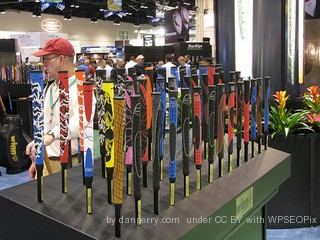Learn about your golf clubs when you have them regripped – to help improve your golf game!
- by danperry.com under CC BY with WPSEOPix
Golfers often have their clubs regripped during the winter months. A few years ago, I wrote a blog post about the value of getting some of your club specifications checked – or rechecked – when you have your clubs regripped. This is still a valuable thing to do. I would say, though, that there is even MORE value in doing this than I thought when I first wrote about this.
You can, if you desire, get a full evaluation of the golf clubs in your bag when you have them regriped – swingweight/MOI, length, lofts and lies, etc. But for today, let's talk about some of the most important – and even simple – things that can be checked about your scoring golf clubs – your driver, wedges, and putter – to be sure you are playing with clubs that optimize your golfing performance.
Your Driver. The key things to check about your driver – particularly if you are not happy with how you are hitting it – are driver loft and face angle, driver length, shaft flex, and club swingweight / MOI. A reason this is more important than ever relates to measuring loft and face angle. Driver lofts and face angles are often not what you might "think" they are. Not only that but – with the advent of drivers that allow variation of lofts and face angles – you may for example be playing with a driver that has an open face when the driver is "set" to "square." Unless you measure these driver specifications, you do not really what they are. And someone, for example, who pushes the ball may be playing with a driver that has an open face angle and Not Know It.
Measuring the butt flex of a driver also gives an indication of how well that shaft fits a particular player's game. A golfer can be playing with a stiff flex shaft and never know it, and be adjusting to that shaft when they play.
Your Wedges. Key wedge information to measure includes wedge bounce and the actual wear pattern on the wedge. This is particularly important for the higher lofted – harder to hit wedges like lob wedges. If you see that your wear pattern on your wedges is near to the leading edge of the club – and not close to or right on the trailing edge – then either that wedge does not have enough bounce to suite your short game, you are using poor technique to hit your wedges shots – lots of forward shaft lean at address – or both. Wedge shots – and confidence with wedge shots – are SO important to your scoring and enjoyment of the game.
Your Putter. The first thing I look at for EVERY putter I see is the grip – if it is one with a flat side, is the grip installed correctly? If not then you are probably manipulating the putter to attempt to get the putter face to line up square at address – not conducive to consistent putting. Also, measurement of the putter loft and putter swingweight can be valuable information. Unless you significantly deloft the putter when you putt, lofts in the range of 2 to 3 degrees are likely to help you roll the golf ball well. And measurement of the putter swingweight can (not always, but can) give an indication if the putter is too light or too heavy for a golfer. Having the right putter weighting is important to being able for putting speed control for all length putts.
There is a LOT you can learn about your golf clubs when you have them regripped. And sometime this information can be worth much more – to your golf scores – that what you pay to have the clubs regripped!
Did you ever learn something about your golf clubs when you had them regripped that allowed you to shoot lower scores – if so, please comment!
The Fit Is IT!!
Tony

